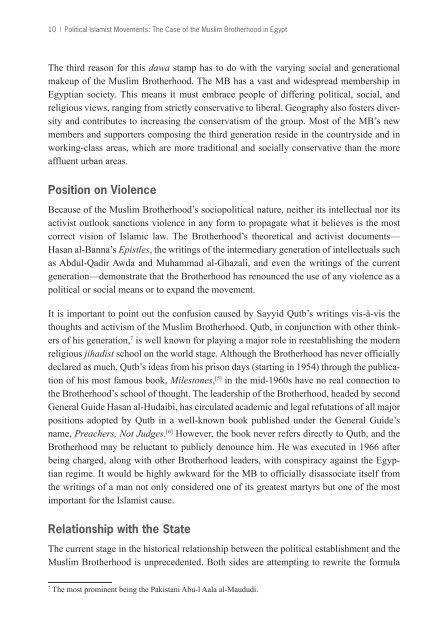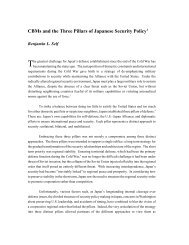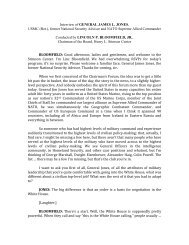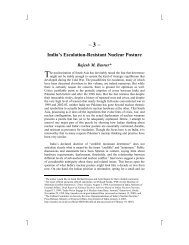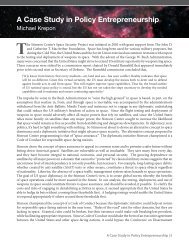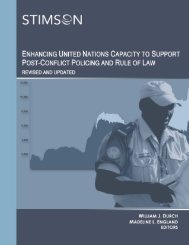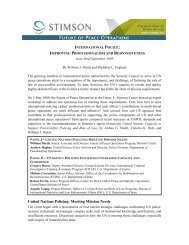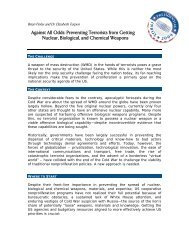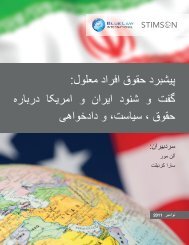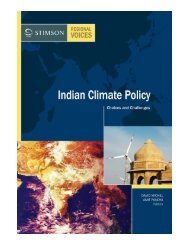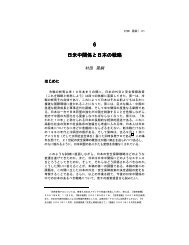Islam and Politics - The Stimson Center
Islam and Politics - The Stimson Center
Islam and Politics - The Stimson Center
You also want an ePaper? Increase the reach of your titles
YUMPU automatically turns print PDFs into web optimized ePapers that Google loves.
10 | Political <strong>Islam</strong>ist Movements: <strong>The</strong> Case of the Muslim Brotherhood in Egypt<br />
<strong>The</strong> third reason for this dawa stamp has to do with the varying social <strong>and</strong> generational<br />
makeup of the Muslim Brotherhood. <strong>The</strong> MB has a vast <strong>and</strong> widespread membership in<br />
Egyptian society. This means it must embrace people of differing political, social, <strong>and</strong><br />
religious views, ranging from strictly conservative to liberal. Geography also fosters diversity<br />
<strong>and</strong> contributes to increasing the conservatism of the group. Most of the MB’s new<br />
members <strong>and</strong> supporters composing the third generation reside in the countryside <strong>and</strong> in<br />
working-class areas, which are more traditional <strong>and</strong> socially conservative than the more<br />
affluent urban areas.<br />
Position on Violence<br />
Because of the Muslim Brotherhood’s sociopolitical nature, neither its intellectual nor its<br />
activist outlook sanctions violence in any form to propagate what it believes is the most<br />
correct vision of <strong>Islam</strong>ic law. <strong>The</strong> Brotherhood’s theoretical <strong>and</strong> activist documents—<br />
Hasan al-Banna’s Epistles, the writings of the intermediary generation of intellectuals such<br />
as Abdul-Qadir Awda <strong>and</strong> Muhammad al-Ghazali, <strong>and</strong> even the writings of the current<br />
generation—demonstrate that the Brotherhood has renounced the use of any violence as a<br />
political or social means or to exp<strong>and</strong> the movement.<br />
It is important to point out the confusion caused by Sayyid Qutb’s writings vis-à-vis the<br />
thoughts <strong>and</strong> activism of the Muslim Brotherhood. Qutb, in conjunction with other thinkers<br />
of his generation, 7 is well known for playing a major role in reestablishing the modern<br />
religious jihadist school on the world stage. Although the Brotherhood has never officially<br />
declared as much, Qutb’s ideas from his prison days (starting in 1954) through the publication<br />
of his most famous book, Milestones, [5] in the mid-1960s have no real connection to<br />
the Brotherhood’s school of thought. <strong>The</strong> leadership of the Brotherhood, headed by second<br />
General Guide Hasan al-Hudaibi, has circulated academic <strong>and</strong> legal refutations of all major<br />
positions adopted by Qutb in a well-known book published under the General Guide’s<br />
name, Preachers, Not Judges. [6] However, the book never refers directly to Qutb, <strong>and</strong> the<br />
Brotherhood may be reluctant to publicly denounce him. He was executed in 1966 after<br />
being charged, along with other Brotherhood leaders, with conspiracy against the Egyptian<br />
regime. It would be highly awkward for the MB to officially disassociate itself from<br />
the writings of a man not only considered one of its greatest martyrs but one of the most<br />
important for the <strong>Islam</strong>ist cause.<br />
Relationship with the State<br />
<strong>The</strong> current stage in the historical relationship between the political establishment <strong>and</strong> the<br />
Muslim Brotherhood is unprecedented. Both sides are attempting to rewrite the formula<br />
7<br />
<strong>The</strong> most prominent being the Pakistani Abu-l Aala al-Maududi.


